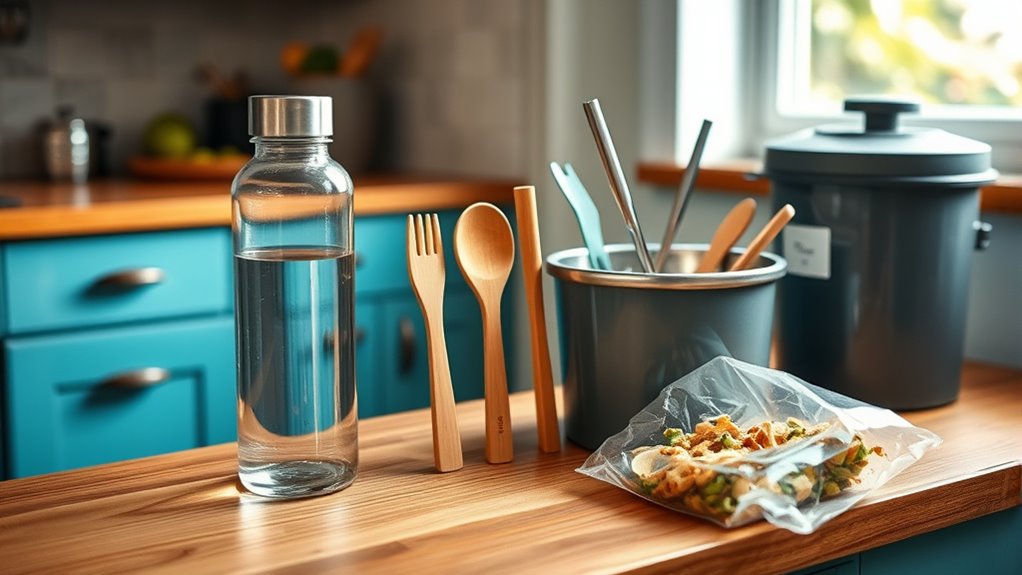You can make a big impact with simple swaps like switching to reusable bags, bottles, and containers, reducing single-use plastics. Turn off lights and unplug devices when not in use, and choose energy-efficient appliances to cut power consumption. Incorporate eco-friendly habits like using reusable coffee cups and snack containers daily. Organize your space to support these efforts and stay committed to sustainable living. Keep going, and you’ll discover even more easy ways to make a difference.
Key Takeaways
- Replace single-use plastics with reusable bags, bottles, and containers to reduce waste and resource consumption.
- Switch to energy-efficient bulbs and unplug devices to conserve electricity in daily routines.
- Upgrade to energy-efficient appliances and improve home insulation to lower overall energy use.
- Use reusable items like water bottles, coffee cups, and snack containers for sustainable daily habits.
- Organize your space to support eco-friendly choices and maintain consistent sustainable practices.

Making small changes in your daily routine can markedly reduce your environmental impact. One of the easiest ways to do this is by switching to reusable packaging whenever possible. Instead of relying on single-use plastic bags, containers, or bottles, opt for items you can refill and reuse. Carry a sturdy cloth bag when grocery shopping, and bring your own reusable containers for leftovers or takeout. Not only does this cut down on waste, but it also reduces the demand for new packaging, which often requires energy-intensive manufacturing processes. Using reusable packaging helps you make a tangible difference in reducing landfill contributions and conserving natural resources.
Switch to reusable packaging to cut waste and conserve resources daily.
Alongside choosing reusable options, focusing on energy conservation is essential. Small adjustments in how you use energy at home can lead to significant environmental benefits. Turning off lights when you leave a room, unplugging devices that aren’t in use, and switching to energy-efficient bulbs are simple steps that add up over time. Consider investing in smart power strips that cut power when devices aren’t active. These habits don’t just save energy—they also lower your electricity bill, making sustainability both eco-friendly and economical.
Switching to energy-conscious appliances and electronics can further enhance your efforts. Look for products with high energy-efficiency ratings, and consider upgrading old appliances that consume more power than newer models. When it’s time to replace items, prioritize those designed to use less energy, which benefits the environment and your wallet. Additionally, optimizing your home’s insulation and sealing any drafts can reduce heating and cooling needs, decreasing energy consumption even more. These small but deliberate adjustments demonstrate how energy conservation isn’t about drastic changes but about mindful choices that collectively make a difference.
Another effective swap is embracing reusable packaging for everyday items like water bottles, coffee cups, and snack containers. Using a durable, reusable water bottle instead of buying bottled water greatly cuts down on plastic waste. Similarly, bringing your own coffee cup to cafes not only minimizes waste but often grants you discounts, creating an incentive to stick with the habit. These simple swaps are easy to integrate into your routine and serve as constant reminders of your commitment to sustainability. Incorporating home organization strategies can also help you maintain a clutter-free environment that supports sustainable living.
Frequently Asked Questions
How Can I Start Small With Sustainable Living?
To start small with sustainable living, focus on manageable changes. You can improve your recycling practices by sorting waste correctly and reducing plastic use. Consider eco-friendly transportation options like biking, walking, or taking public transit whenever possible. These small steps make a difference, and over time, they can lead to bigger eco-conscious habits. Remember, every effort counts, and starting with simple swaps helps you build a more sustainable lifestyle gradually.
Are Eco-Friendly Products More Affordable Than Traditional Ones?
Imagine you’re in a bustling marketplace of the 1920s, weighing choices. Eco-friendly products often cost more upfront, but the cost comparison varies. Many are now affordable, matching traditional options, especially with ongoing sales or bulk buying. While some eco-friendly items have higher product affordability, others are budget-friendly. Over time, sustainable choices can save money, making eco-products a smart, cost-effective option for those seeking both value and environmental impact.
What Are the Biggest Challenges in Adopting Sustainable Habits?
When you try to adopt sustainable habits, you often face challenges like reducing plastic waste and changing ingrained lifestyle habits. These shifts can feel overwhelming, especially when convenience and cost come into play. You might struggle with finding affordable eco-friendly options or breaking old routines. But with small, consistent steps, you can gradually overcome these obstacles and make sustainability a natural part of your daily life.
How Do I Involve My Family in Eco-Friendly Changes?
Imagine planting seeds of change within your family’s daily routine. You can involve them in eco-friendly activities like gardening or recycling, turning it into fun family projects. Use education strategies to share the importance of sustainability gently, inspiring curiosity and teamwork. Engage everyone by setting small, achievable goals, celebrating progress together. Your enthusiasm and patience will help your family embrace eco-conscious habits as a shared journey, not just individual efforts.
Can Sustainable Swaps Significantly Reduce My Carbon Footprint?
Sustainable swaps can considerably reduce your carbon footprint by encouraging renewable energy use and waste reduction. When you switch to renewable energy sources like solar or wind, you cut down on fossil fuel emissions. Additionally, reducing waste by recycling and composting minimizes landfill impact. These simple changes make a real difference, helping the environment and promoting a more sustainable lifestyle. Your actions, no matter how small, contribute to a healthier planet.
Conclusion
By making these simple swaps, you’re planting seeds for a greener tomorrow. Imagine your daily choices as tiny drops of water—they ripple outward, creating waves of change. Each conscious decision brightens the Earth’s garden, turning your life into a vibrant, flourishing landscape of sustainability. So go ahead, embrace these small shifts—your actions are the sunlight that helps this beautiful planet bloom brighter with every step you take.









